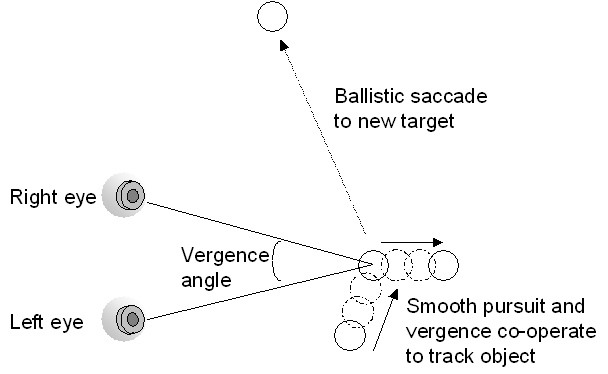Kismet's visual-motor control is modeled after the human ocular-motor
system. The human system is so good at providing a stable percept of
the world that we have no intuitive appreciation of the physical
constraints under which it operates.
Humans have foveate vision. The fovea (the center of the retina) has
a much higher density of photoreceptors than the periphery. This
means that to see an object clearly, humans must move their eyes such
that the image of the object falls on the fovea. Human eye movement
is not smooth. It is composed of many quick jumps, called saccades,
which rapidly re-orient the eye to project a different part of the
visual scene onto the fovea. After a saccade, there is typically a
period of fixation, during which the eyes are relatively stable. They
are by no means stationary, and continue to engage in corrective
micro-saccades and other small movements. If the eyes fixate on a
moving object, they can follow it with a continuous tracking movement
called smooth pursuit. This type of eye movement cannot be evoked
voluntarily, but only occurs in the presence of a moving object.
Periods of fixation typically end after some hundreds of milliseconds,
after which a new saccade will occur.
The eyes normally move in lock-step, making equal, conjunctive
movements. For a close object, the eyes need to turn towards each
other somewhat to correctly image the object on the foveae of the two
eyes. These disjunctive movements are called vergence, and rely on
depth perception (see figure).
Since the eyes are located on the head, they need to compensate for
any head movements that occur during fixation. The vestibulo-ocular
reflex uses inertial feedback from the vestibular system to keep the
orientation of the eyes stable as the eyes move. This is a very fast
response, but is prone to the accumulation of error over time. The
opto-kinetic response is a slower compensation mechanism that uses a
measure of the visual slip of the image across the retina to correct
for drift. These two mechanisms work together to give humans stable
gaze as the head moves.
Our implementation of an ocular-motor system is an approximation of
the human system. Kismet's eyes periodically saccade to new targets
chosen by the attention system, tracking them smoothly if they move
and the robot wishes to engage them.
Vergence eye movements are more challenging, since errors in
disjunctive eye movements can give the eyes a disturbing appearance of
moving independently. Errors in conjunctive movements have a much
smaller impact on an observer, since the eyes clearly move in
lock-step.

Humans exhibit four characteristic types of eye motion. Saccadic
movements are high-speed ballistic motions that center a target in the
field of view. Smooth pursuit movements are used to track a moving
object at low velocities. The vestibulo-ocular and opto-kinetic
reflexes act to maintain the angle of gaze as the head and body move
through the world. Vergence movements serve to maintain an object in
the center of the field of view of both eyes as the object moves in
depth.
|
|


